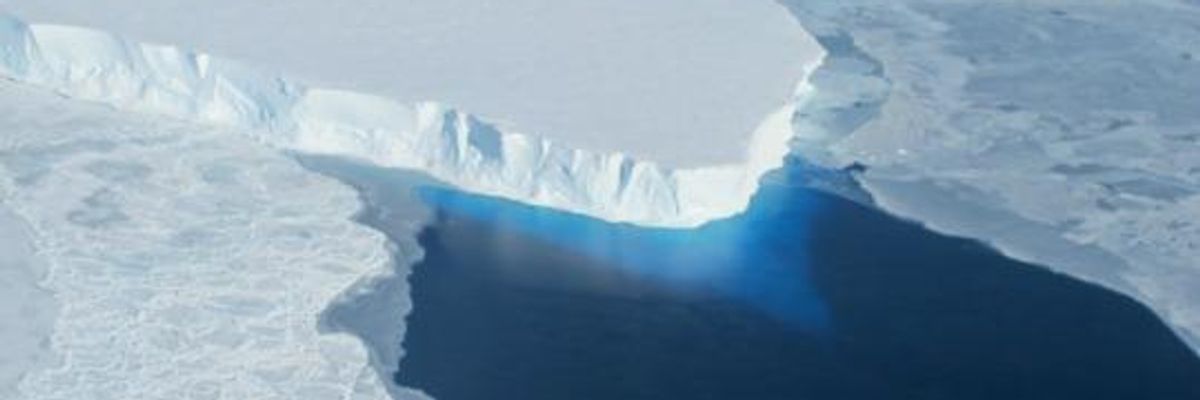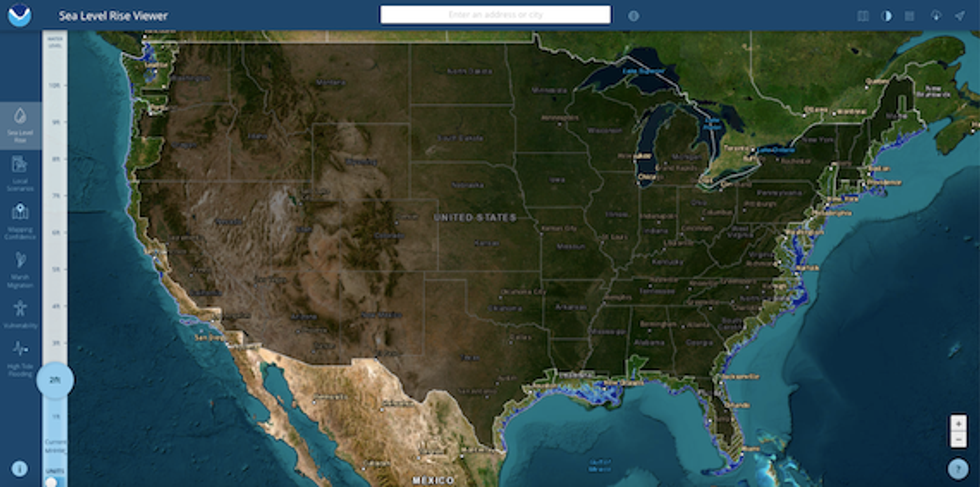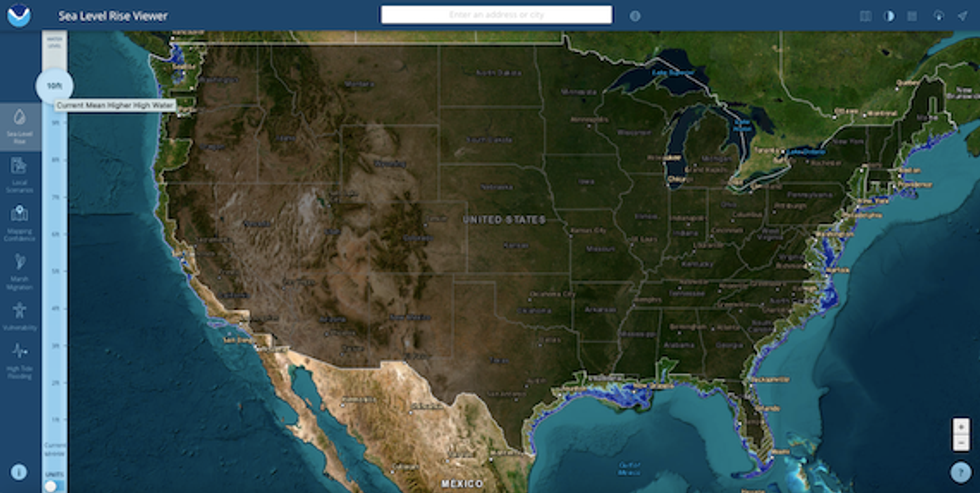
Thwaites Glacier is melting in ways researchers previously did not understand. And it's not good news. Image credit: NASA
Ominous News From Deep Beneath Doomsday Glacier
What researchers found is that weird stuff is going on down there that could speed up the day when Thwaites takes a swim.
The Thwaites Glacier in Antarctica—the so-called "Doomsday Glacier"—is in the news again. We are fascinated with it because it is the Godzilla of glaciers, 80 miles across and as massive as Florida. If the ice sheet holding it back were to melt, and if Thwaites plopped into the ocean, it would all by itself raise sea level two feet. It functions, however, to hold back other glaciers and ice formations, which in its absence would themselves head for the sea. If that happened you would be talking about ten feet of sea level rise. The last time I discussed it, Alastair G.C. Graham had just shown that glaciers sometimes move very quickly. This finding has been widely accepted by scientists.
B.E. Schmidt and colleagues write in a paper for Nature that scientists piloted an underwater vehicle beneath the ice shelf and the Thwaites glacier. Eat your heart out, James Cameron! They found that the glacier is melting a little slower than had been feared, but that since 2010 it has nevertheless shrunk consistently and fairly rapidly. Worse, much worse was their finding that there are big cracks in the glacier and terraced indentations from below that they call ‘staircase-like’ structures. These weak spots are exposed to relatively warm water, at a temperature of 2°C, i.e., 35.6°F, from beneath, and the glacier is melting especially rapidly at these weak hot points.
The scientists write that “The varied topography [i.e. the cracks and staircases] of the ice base at the GL [the grounding line where the ice shelf meets the ocean], carved as it flowed over the bed before reaching the ocean, becomes a broadly distributed network of sloped ice surfaces along which melting is promoted.”
The important phrase here is melting is promoted. You never want to hear that in Antarctica.
The National Oceanic and Atmospheric Agency (NOAA) has a neat sea level viewer. I entered two feet of sea level rise into it, and this is what the United States looks like under that condition:
That’s a lot of coast missing. And cities. Isn’t the map showing Miami, Savannah and New Orleans as not there any more?
Then I put in 10 feet sea level rise:
It looks like San Diego, San Francisco and Seattle are gone now, too. And Rhode Island and Boston.
We are not talking about hypotheticals. Likely this amount of sea level is locked in, and four to six feet of sea level is predicted by the end of this century by the IPCC. That prediction, however, does not take into account the possibility that the Thwaites Glacier may take a dive.
So the only question is the pace and the time scale of this change. I think what the team that went down in their underwater vehicle found is that weird stuff is going on down there that could speed up T-day, the day when Thwaites takes a swim.
Another team of scientists, as reported by Peter E. D. Davis et al. in Nature, as well, drilled into Thwaites with a warm drill. They found that although some of it is shielded from warm water by a layer of colder water, even a little heat goes a long way toward increasing the rate of melt: “rapid and possibly unstable grounding-line retreat may be associated with relatively modest basal melt rates.” They drilled into a part of the glacier that is melting more slowly, but observe that the “main trunk” is rapidly retreating.
Their conclusion is not encouraging: “Nevertheless, sustained grounding-zone basal melting, weaker ice-shelf buttressing and the advection of increasingly thinner ice over the grounding line will continue to condition TEIS to persistent retreat in the future, even without a strong positive feedback from elevated basal melting.”
In otherwords, the thing is going to go on melting. And that ain’t good.
An Urgent Message From Our Co-Founder
Dear Common Dreams reader, The U.S. is on a fast track to authoritarianism like nothing I've ever seen. Meanwhile, corporate news outlets are utterly capitulating to Trump, twisting their coverage to avoid drawing his ire while lining up to stuff cash in his pockets. That's why I believe that Common Dreams is doing the best and most consequential reporting that we've ever done. Our small but mighty team is a progressive reporting powerhouse, covering the news every day that the corporate media never will. Our mission has always been simple: To inform. To inspire. And to ignite change for the common good. Now here's the key piece that I want all our readers to understand: None of this would be possible without your financial support. That's not just some fundraising cliche. It's the absolute and literal truth. We don't accept corporate advertising and never will. We don't have a paywall because we don't think people should be blocked from critical news based on their ability to pay. Everything we do is funded by the donations of readers like you. Will you donate now to help power the nonprofit, independent reporting of Common Dreams? Thank you for being a vital member of our community. Together, we can keep independent journalism alive when it’s needed most. - Craig Brown, Co-founder |
The Thwaites Glacier in Antarctica—the so-called "Doomsday Glacier"—is in the news again. We are fascinated with it because it is the Godzilla of glaciers, 80 miles across and as massive as Florida. If the ice sheet holding it back were to melt, and if Thwaites plopped into the ocean, it would all by itself raise sea level two feet. It functions, however, to hold back other glaciers and ice formations, which in its absence would themselves head for the sea. If that happened you would be talking about ten feet of sea level rise. The last time I discussed it, Alastair G.C. Graham had just shown that glaciers sometimes move very quickly. This finding has been widely accepted by scientists.
B.E. Schmidt and colleagues write in a paper for Nature that scientists piloted an underwater vehicle beneath the ice shelf and the Thwaites glacier. Eat your heart out, James Cameron! They found that the glacier is melting a little slower than had been feared, but that since 2010 it has nevertheless shrunk consistently and fairly rapidly. Worse, much worse was their finding that there are big cracks in the glacier and terraced indentations from below that they call ‘staircase-like’ structures. These weak spots are exposed to relatively warm water, at a temperature of 2°C, i.e., 35.6°F, from beneath, and the glacier is melting especially rapidly at these weak hot points.
The scientists write that “The varied topography [i.e. the cracks and staircases] of the ice base at the GL [the grounding line where the ice shelf meets the ocean], carved as it flowed over the bed before reaching the ocean, becomes a broadly distributed network of sloped ice surfaces along which melting is promoted.”
The important phrase here is melting is promoted. You never want to hear that in Antarctica.
The National Oceanic and Atmospheric Agency (NOAA) has a neat sea level viewer. I entered two feet of sea level rise into it, and this is what the United States looks like under that condition:
That’s a lot of coast missing. And cities. Isn’t the map showing Miami, Savannah and New Orleans as not there any more?
Then I put in 10 feet sea level rise:
It looks like San Diego, San Francisco and Seattle are gone now, too. And Rhode Island and Boston.
We are not talking about hypotheticals. Likely this amount of sea level is locked in, and four to six feet of sea level is predicted by the end of this century by the IPCC. That prediction, however, does not take into account the possibility that the Thwaites Glacier may take a dive.
So the only question is the pace and the time scale of this change. I think what the team that went down in their underwater vehicle found is that weird stuff is going on down there that could speed up T-day, the day when Thwaites takes a swim.
Another team of scientists, as reported by Peter E. D. Davis et al. in Nature, as well, drilled into Thwaites with a warm drill. They found that although some of it is shielded from warm water by a layer of colder water, even a little heat goes a long way toward increasing the rate of melt: “rapid and possibly unstable grounding-line retreat may be associated with relatively modest basal melt rates.” They drilled into a part of the glacier that is melting more slowly, but observe that the “main trunk” is rapidly retreating.
Their conclusion is not encouraging: “Nevertheless, sustained grounding-zone basal melting, weaker ice-shelf buttressing and the advection of increasingly thinner ice over the grounding line will continue to condition TEIS to persistent retreat in the future, even without a strong positive feedback from elevated basal melting.”
In otherwords, the thing is going to go on melting. And that ain’t good.
The Thwaites Glacier in Antarctica—the so-called "Doomsday Glacier"—is in the news again. We are fascinated with it because it is the Godzilla of glaciers, 80 miles across and as massive as Florida. If the ice sheet holding it back were to melt, and if Thwaites plopped into the ocean, it would all by itself raise sea level two feet. It functions, however, to hold back other glaciers and ice formations, which in its absence would themselves head for the sea. If that happened you would be talking about ten feet of sea level rise. The last time I discussed it, Alastair G.C. Graham had just shown that glaciers sometimes move very quickly. This finding has been widely accepted by scientists.
B.E. Schmidt and colleagues write in a paper for Nature that scientists piloted an underwater vehicle beneath the ice shelf and the Thwaites glacier. Eat your heart out, James Cameron! They found that the glacier is melting a little slower than had been feared, but that since 2010 it has nevertheless shrunk consistently and fairly rapidly. Worse, much worse was their finding that there are big cracks in the glacier and terraced indentations from below that they call ‘staircase-like’ structures. These weak spots are exposed to relatively warm water, at a temperature of 2°C, i.e., 35.6°F, from beneath, and the glacier is melting especially rapidly at these weak hot points.
The scientists write that “The varied topography [i.e. the cracks and staircases] of the ice base at the GL [the grounding line where the ice shelf meets the ocean], carved as it flowed over the bed before reaching the ocean, becomes a broadly distributed network of sloped ice surfaces along which melting is promoted.”
The important phrase here is melting is promoted. You never want to hear that in Antarctica.
The National Oceanic and Atmospheric Agency (NOAA) has a neat sea level viewer. I entered two feet of sea level rise into it, and this is what the United States looks like under that condition:
That’s a lot of coast missing. And cities. Isn’t the map showing Miami, Savannah and New Orleans as not there any more?
Then I put in 10 feet sea level rise:
It looks like San Diego, San Francisco and Seattle are gone now, too. And Rhode Island and Boston.
We are not talking about hypotheticals. Likely this amount of sea level is locked in, and four to six feet of sea level is predicted by the end of this century by the IPCC. That prediction, however, does not take into account the possibility that the Thwaites Glacier may take a dive.
So the only question is the pace and the time scale of this change. I think what the team that went down in their underwater vehicle found is that weird stuff is going on down there that could speed up T-day, the day when Thwaites takes a swim.
Another team of scientists, as reported by Peter E. D. Davis et al. in Nature, as well, drilled into Thwaites with a warm drill. They found that although some of it is shielded from warm water by a layer of colder water, even a little heat goes a long way toward increasing the rate of melt: “rapid and possibly unstable grounding-line retreat may be associated with relatively modest basal melt rates.” They drilled into a part of the glacier that is melting more slowly, but observe that the “main trunk” is rapidly retreating.
Their conclusion is not encouraging: “Nevertheless, sustained grounding-zone basal melting, weaker ice-shelf buttressing and the advection of increasingly thinner ice over the grounding line will continue to condition TEIS to persistent retreat in the future, even without a strong positive feedback from elevated basal melting.”
In otherwords, the thing is going to go on melting. And that ain’t good.



